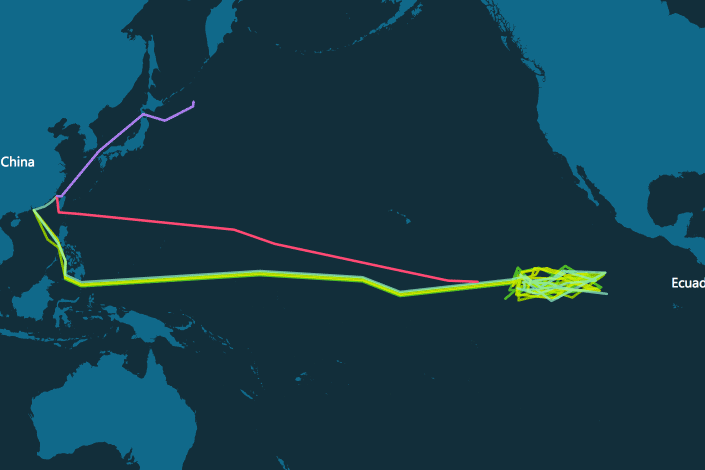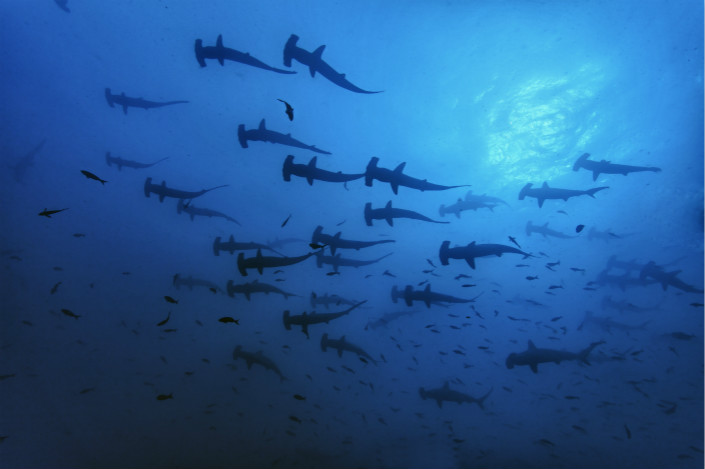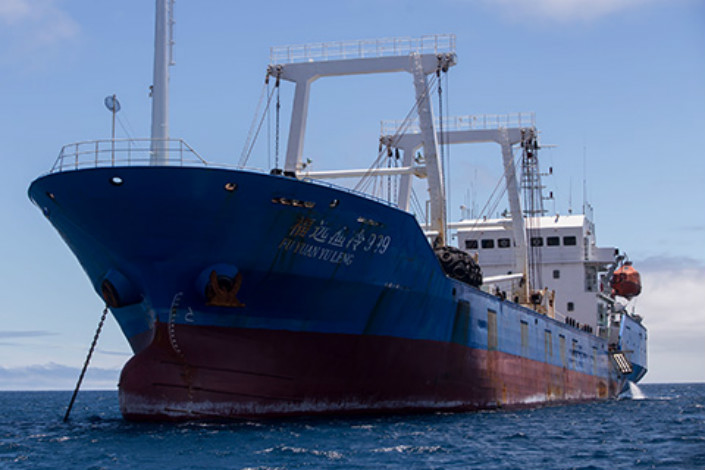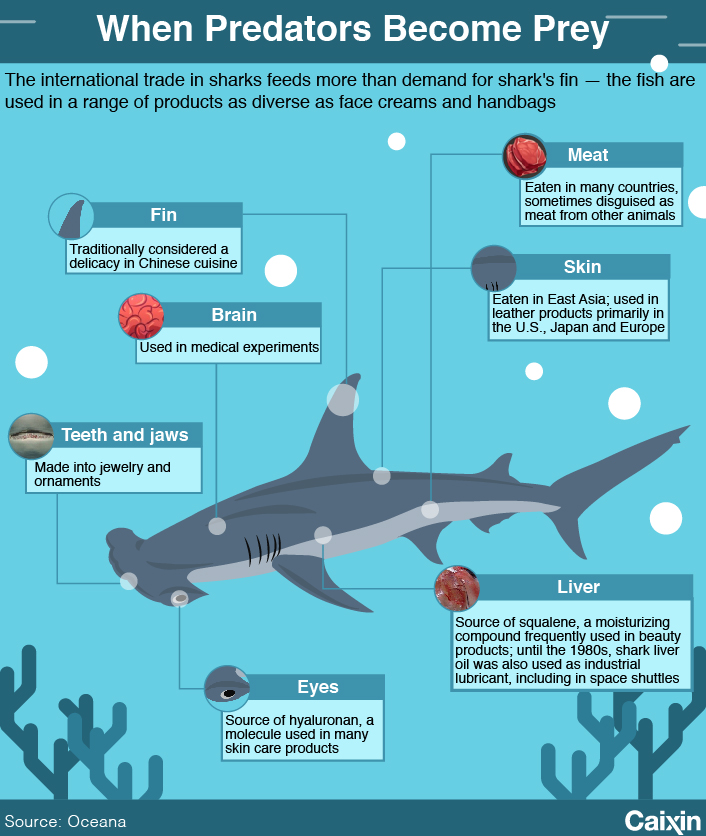How Did 6,223 Sharks End Up on Ship With No Fishing Equipment?

In August, Ecuadorean coast guards encountered a shocking sight on board a China-flagged ship intercepted within the Galapagos Marine Reserve — a hold filled to the ceiling with shark carcasses.
The loot on the ship, Fu Yuan Yu Leng 999, included baby sharks and endangered species like the scalloped hammerhead.
A court in San Cristobal, one of the ecologically rich Galapagos Islands, found the 20 crew on board the Fu Yuan Yu Leng 999 guilty of breaking Ecuador’s Integral Criminal Organic Code by illegally transporting wildlife. Shark fishing as bycatch is legal in some Ecuadorean waters, but not within the Galapagos Marine Reserve.
The crew members were each sentenced to one to four years of prison and fined a total $5.9 million.
But the trial left one major question unanswered: Who had hunted the sharks that the Fu Yuan Yu Leng 999 was transporting?
Loading…
Two Taiwan vessels
The first possible explanation came from Galapagos National Park authorities, who in their announcement of the case said that Fu Yuan Yu Leng 999’s catch had been obtained from two Taiwan vessels, Hai Fang 301 and Hai Fang 302, between Aug. 5 and Aug.7.
Fu Yuan Yu Leng 999, the ship stopped by Ecuadorean authorities, was a “reefer,” or refrigerated cargo ship, capable only of receiving catch from smaller fishing vessels. In an Aug. 31 interview with the ANDES news agency, China’s ambassador to Ecuador, Wang Yulin, said “it was confirmed that this was not a fishing but a transport vessel.”
China’s Ministry of Agriculture corroborated the Galapagos National Park’s account. An official at the Ministry of Agriculture’s fisheries administration told Caixin on Sept. 5 that Ecuadorian authorities had identified the Taiwan boats based on receipts found on board the Fu Yuan Yu Leng 999. Fu Yuan Yu Leng 999’s captain had also confirmed the matter with the fishery administration in a phone call, the Chinese official said.
But an ongoing search by Caixin through international databases has not turned up any vessels registered under the names Hai Fang 301 and Hai Fang 302. Additionally, on Sept. 4, Taiwan’s fisheries authority said no vessels named Hai Fang 301 and Hai Fang 302 had been registered with Taiwan authorities. No Taiwan boats have carried out any fishing activities in the area, Huang Hung-yan, deputy director-general of Taiwan’s Fisheries Agency, told Caixin.
Caixin reached out to the Chinese fisheries authority again. On Sept. 8, China’s fisheries authority told Caixin that it had been investigating the Fu Yuan Yu Leng 999 since the ship was seized. “As far as the Ministry of Agriculture has learned, the cargo onboard the ship was received from two Taiwan-flagged fishing boats, Hai Fang 301 and Hai Fang 302,” the authorities responded in a written statement, adding that Ecuadorian authorities and their media reports have confirmed that.
Big data
Amid the official confusion over the “Hai Fang” boats, a different picture seemed to be emerging from the realm of big data.
On Aug. 28, Global Fishing Watch — an nongovernmental organization (NGO) committed to transparency in commercial fishing that was founded by Google, Oceana, and SkyTruth — published the results of its investigation into Fu Yuan Yu Leng 999’s journey to Ecuador. Using the reefer’s Automatic Identification System data, which ships normally use to prevent collisions, Skytruth and Global Fishing Watch analysts had found that Fu Yuan Yu Leng 999 had spent about 12 hours at a time moving only 30 meters (98 feet) apart from four Chinese flagged-vessels between Aug. 5 and Aug. 7. The four vessels were the tuna longliners Fu Yuan Yu 7866, Fu Yuan Yu 7861, Fu Yuan Yu 7865, and Fu Yuan Yu 7862, Global Fishing Watch said.
 |
The scalloped hammerhead (pictured), which was added to the list of globally endangered shark species in 2008, was one type of shark identified on the Fu Yuan Yu Leng 999. Hammerheads are among the sharks most often caught for their fins, according to a 2008 article by the science website RedOrbit.com. A large shark fin can sell for more than $100 a kilogram. Shark fins are an essential ingredient of shark fin soup, a popular dish often served at high-end weddings and other banquets in China and other parts of East Asia. Photo: Visual China |
Caixin then turned to pioneering maritime analytics company Windward for a second opinion. Windward is an Israeli firm that uses big data and AI technology to create a behavioral profile for each vessel, while screening out hacking or GPS manipulation. It is known for being able to detect anomalous activities, such as ship-to-ship joining, or ships traveling uneconomical and suspicious routes.
Windward reached essentially the same findings, using their data aggregation platform. Windward said it appeared that Fu Yuan Yu Leng 999 had left Fuzhou, in China’s Fujian province, on July 7. It headed toward the southeast Pacific. Between Aug. 5 and Aug. 7, Fu Yuan Yu Leng 999 had rendezvous of eight to 15 hours with four fishing vessels — the same four Global Fishing Watch had listed. Then, on Aug. 13, it was apprehended by Ecuadorean government vessels.
“This (the four long rendezvous) was Fu Yuan Yu Leng 999’s opportunity to receive large loads of fish,” Yoav Gannot, analyst at Windward, told Caixin. “Our system also discovered the Fu Yuan Yu Leng 999 showed atypical behavior for three hours on July 28, but this was too short a period of time for massive amounts of cargo to be transferred.”
 |
Fu Yuan Yu Leng 999, the ship stopped by Ecuadorean authorities, was a refrigerated cargo ship, capable only of receiving catches from smaller fishing vessels. Photo: Visual China |
Chinese fishery authorities had told Caixin on Sept. 4 that some fishing vessels engaging in illegal fishing may turn off their satellite positioning systems while at sea to escape surveillance.
But Gannot said Windward’s system was able to identify ships that deliberately turn off their positioning systems during their journey. The odds of there having been two Taiwan ships sailing complete routes without ever turning on their Automatic Identification Systems were extremely slim, multiple ocean fishing experts told Caixin.
A Fujian family
So who owned the Fu Yuan Yus 7866, 7861, 7865, and 7862, that the big-data experts say most probably gave Fu Yuan Yu Leng 999 its illegal cargo?
In late August, authorities in Fujian province told Caixin that the Fu Yuan Yu Leng 999 belongs to Fuzhou Honglong Ocean Aquatic Products, a company registered in Fuzhou, the provincial capital.
A further investigation by Caixin revealed that Fuzhou Honglong has close links to Nasdaq-listed Chinese fishing giant Pingtan Marine Enterprise Ltd., and that the largest stakeholders of the two companies are members of the same family.
Caixin found Fu Yuan Yu 7861 and Fu Yuan Yu 7862 listed as vessels in the Pingtan Marine Enterprises’ longline fishing fleet, in a May press release about the company, which is China’s second-largest ocean-fishing firm.
 |
Caixin was unable to contact Fuzhou Honglong. Caixin visited the Fujian address of Fuzhou Honglong but found no sign of the company there. However, there were offices belonging to three other companies, including Pingtan Marine Enterprise, at the address. The Pingtan Marine Enterprise receptionist told Caixin that his company had no links to Fuzhou Honglong.
However, Pingtan Marine Enterprise’s 2016 annual report, published on March 23, said that “Fuzhou Honglong’s main shareholder is Lin Ping, the spouse of our company’s Chairman and Chief Executive Officer Zhuo Xinrong.” The report said that Zhuo held a 56.2% stake in Pingtan Marine Enterprises, while Lin held a 66.5% stake in Honglong.
According to other documents seen by Caixin, Lin Ping transferred her shares in Honglong to a company owned by Zhuo Longjie, who appears on the Pingtan Marine Enterprises’ list of directors.
Caixin was eventually able to reach Zhuo Xinrong, Pingtan Marine Enterprises chairman. Zhuo Xinrong told Caixin that Fuzhou Honglong belonged to his brother, and that he had no personal understanding of the Fu Yuan Yu Leng 999 case.
Zhuo Xinrong also told Caixin on Sept. 4 that the captain of the Fu Yuan Yu Leng 999 was an old friend of the Taiwan boats’ captains. “The captain saw that his old friends’ holds were full, while there was still space on his ship, so he helped them carry some cargo,” Zhuo Xinrong said. He refused to answer when asked what cargo Fu Yuan Yu 7861 and Fu Yuan Yu 7862, which his company owns, loaded onto Fu Yuan Yu Leng 999.
After the family connection was uncovered between Fuzhou Honglong and Pingtan Marine Enterprises, Caixin searched records for other fishery businesses belonging to the Zhuo family.
Caixin found a company registered under Zhuo Honghong, the daughter of Zhuo Xinrong, with a name that seemed familiar: Fuzhou Hai Feng Dafu Ocean Fishery Co., Ltd. Its registered address was in the same building as Pingtan Marine Enterprises, but the building manager at the address said he had never heard of Fuzhou Hai Feng.
“Hai Feng” sounds similar to the names of the boats Galapagos authorities had said were the sources of Fu Yuan Yu Leng 999’s cargo — Hai Fang 301 and Hai Fang 302. Caixin searched records for “Hai Feng 301” instead of “Hai Fang 301,” and found the details of a vessel with that name, including this detail: Hai Fang 301 had now been renamed Hai Fa, and Hai Fa was the name of a ship whose crew was found guilty by an Indonesian court in 2015 of illegally transporting shark species.
Global Fishing Watch's tracking data showed Hai Fa docked in Fuzhou at the same time as Fu Yuan Yu Leng 999 — between July 2 and 5. But Hai Fa was in water near Japan around Aug. 5-7, making a transfer between Hai Fa and Fu Yuan Yu Leng 999 highly unlikely.
Indonesian court records said Hai Fa belonged to a Hong Kong-registered company, Hai Yi Shipping Ltd. The Chinese name of Hai Yi Shipping Ltd., according to Hong Kong company registration data, is Haiyi Hangyun — a company that appears in Pingtan Marine Enterprises’ 2016 report.
A legal adviser to the Galapagos National Park, Juan Andres Delgado Garrido, allowed Caixin to access records from the Fu Yuan Yu Leng 999. On Sept. 12, Caixin found that the legal documents listed Hai Feng 301 and Hai Feng 302 as the two vessels that had appeared on Fu Yuan Yu Leng 999’s shipment receipt — not Hai Fang 301 and Hai Fang 302, as originally reported by the Galapagos Authorities.
Delgado Garrido told Caixin that the Galapagos announcement misspelled the two ships’ names, and confirmed the version of the names listed in the documents.
This article has been updated to clarify that Global Fishing Watch, an NGO committed to transparency in commercial fishing, investigated Fu Yuan Yu Leng 999’s journey to Ecuador.
Contact reporter Teng Jing Xuan (jingxuanteng@caixin.com)
- MOST POPULAR






